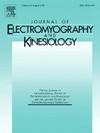The angle-based dynamic control ratio in isokinetic fatiguing knee flexion–extension effort: A study of healthy subjects
IF 2.3
4区 医学
Q3 NEUROSCIENCES
引用次数: 0
Abstract
This study examined the angle-based variations in the dynamic control ratio (DCRab), defined as the peak concentric moment of the quadriceps (Qcon) divided by its hamstring counterpart (Hecc) when calculated calculated at 1° intervals, during isokinetic fatiguing conditions. Sixteen men performed 30 maximal concentric knee extensions and eccentric flexions of the right and left knees at speeds of 120°/s and 180°/s. Data were analyzed using ratio values extracted from three repetition segments (4–6, 14–16, and 27–29) and presented graphically. All DCRab curves followed asymmetric second-order patterns, with the values near end-RoM (full extension: 5–7°) significantly higher than at RoM onset (95° of flexion), reflecting increased hamstring moment output. Fatigue reduced the Q and H moment at the equilibrium point [DCRe(M); Hecc = Qcon] and shifted the angle at which the DCRe occurred [DCRe(∠)] rightward, indicating altered muscle balance. DCRe(M) correlated with DCRe(∠): r = 0.84–0.90, while the DCRe(∠) correlated with angle of peak moment (r = 0.63–0.88), especially at 180°/s. Notably, the DCRe(∠) occurred at 20–30° of knee extension and correlated with the angle of peak moment of Hecc at 180°/s, indicating enhanced joint protection. No significant inter-limb differences were found in either Qcon or Hecc strength (p = 0.520). The use of the DCRab and its derivatives, the DCRe(M) and DCRe(∠) indicates that fatigue may affect Q-H balance. Thus, these parameters may aid in assessing the risk of knee injury and design of rehabilitation protocols.
基于角度的等运动疲劳膝关节屈伸力动态控制率:健康受试者的研究。
本研究检查了动态控制比(DCRab)的角度变化,DCRab定义为四头肌(Qcon)的峰值同心力矩除以腿筋(Hecc),在等速疲劳条件下以1°间隔计算。16名男性以120°/s和180°/s的速度进行30次最大同心膝关节伸展和左右膝关节偏心屈曲。使用从3个重复片段(4-6、14-16和27-29)中提取的比率值对数据进行分析,并以图表形式呈现。所有DCRab曲线均呈非对称的二阶模式,近踝关节末端(完全伸展:5-7°)的值明显高于踝关节起始(屈曲95°),反映出腘绳肌力矩输出增加。疲劳降低了平衡点处的Q矩和H矩[DCRe(M)];Hecc = Qcon]并将DCRe发生的角度[DCRe(∠)]向右移动,表明肌肉平衡发生了改变。DCRe(M)与DCRe(∠)的相关系数r = 0.84 ~ 0.90,而DCRe(∠)与峰值弯矩角的相关系数r = 0.63 ~ 0.88,尤其在180°/s处。值得注意的是,DCRe(∠)出现在膝关节伸展20 ~ 30°处,且与Hecc在180°/s处的峰值弯矩角度相关,说明关节保护作用增强。两组间Qcon和Hecc强度均无显著差异(p = 0.520)。DCRab及其衍生物dre (M)和dre(∠)的使用表明,疲劳可能会影响Q-H平衡。因此,这些参数可能有助于评估膝关节损伤的风险和设计康复方案。
本文章由计算机程序翻译,如有差异,请以英文原文为准。
求助全文
约1分钟内获得全文
求助全文
来源期刊
CiteScore
4.70
自引率
8.00%
发文量
70
审稿时长
74 days
期刊介绍:
Journal of Electromyography & Kinesiology is the primary source for outstanding original articles on the study of human movement from muscle contraction via its motor units and sensory system to integrated motion through mechanical and electrical detection techniques.
As the official publication of the International Society of Electrophysiology and Kinesiology, the journal is dedicated to publishing the best work in all areas of electromyography and kinesiology, including: control of movement, muscle fatigue, muscle and nerve properties, joint biomechanics and electrical stimulation. Applications in rehabilitation, sports & exercise, motion analysis, ergonomics, alternative & complimentary medicine, measures of human performance and technical articles on electromyographic signal processing are welcome.

 求助内容:
求助内容: 应助结果提醒方式:
应助结果提醒方式:


